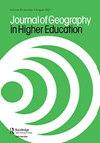Use of an augmented reality sand table for satellite remote sensing education
IF 1
4区 教育学
Q2 EDUCATION & EDUCATIONAL RESEARCH
引用次数: 1
Abstract
ABSTRACT This experiment utilized advanced visualization technology for the delivery of an introductory remote sensing lesson in an undergraduate geography course. Given the numerous immersive visualization solutions available, it is now possible to leverage the capabilities of augmented, mixed, and virtual reality (AR, MR, and VR) technology in a classroom learning environment. For instructors, it is important to understand how advanced visualization technologies can enhance the learning experience and enable greater knowledge retention. To validate the use of an AR sand table/sandbox in a group academic setting, approximately 400 participants were evaluated to assess the impact on students’ retention of both foundational and practical remote sensing concepts. This work represents a between-subjects design with two AR sand table experimental groups (instructor sand table interaction, and student sand table interaction) and one control group with no sand table exposure. The use of the AR sand table in a classroom environment was found to improve retention of foundational remote sensing knowledge and elevate the assessment performance for subjects identified as lower performers.利用增强现实沙盘进行卫星遥感教育
本实验利用先进的可视化技术,在本科地理课程中提供遥感导论课程。考虑到众多的沉浸式可视化解决方案,现在可以在课堂学习环境中利用增强现实、混合现实和虚拟现实(AR、MR和VR)技术的功能。对于教师来说,重要的是要了解先进的可视化技术如何增强学习体验并使知识保留得更好。为了验证AR沙盘/沙盒在小组学术环境中的使用,对大约400名参与者进行了评估,以评估对学生保留基础和实用遥感概念的影响。本研究采用受试者间设计,包括两个AR沙盘实验组(教师沙盘互动和学生沙盘互动)和一个不接触沙盘的对照组。在课堂环境中使用AR沙盘可以改善基础遥感知识的保留,并提高被认为表现较差的科目的评估绩效。
本文章由计算机程序翻译,如有差异,请以英文原文为准。
求助全文
约1分钟内获得全文
求助全文
来源期刊

Journal of Geography in Higher Education
Multiple-
CiteScore
5.80
自引率
9.50%
发文量
29
期刊介绍:
The Journal of Geography in Higher Education ( JGHE) was founded upon the conviction that the development of learning and teaching was vitally important to higher education. It is committed to promote, enhance and share geography learning and teaching in all institutions of higher education throughout the world, and provides a forum for geographers and others, regardless of their specialisms, to discuss common educational interests, to present the results of educational research, and to advocate new ideas.
 求助内容:
求助内容: 应助结果提醒方式:
应助结果提醒方式:


